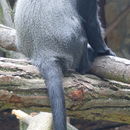Biology
(
Anglèis
)
fornì da Arkive
Noisy and gregarious, the tree-dwelling greater spot-nosed guenon generally lives in large groups of between 12 and 30 animals, comprising a single adult male, with several females and their young (1) (5).This species is frequently found in close association with related guenon species, such as the crowned guenon (Cercopithecus pogonias), forming large, mixed-species groups. This helps to protect against predation, and also allows the sharing of information about the best foraging locations (6). While the bulk of the greater spot-nosed guenon's diet consists of fruit, seeds and leaves, it will also eat insects and agricultural crops (2) (3).
Male greater spot-nosed guenons produce a range of vocalizations including deep, booming calls to advertise status and presence, as well as “pyow” and “hack” alarm calls. Incredibly, the sequence of these two alarm calls can convey information to other greater spot-nosed guenons about what kind of predator is nearby, for example, whether it is a bird of prey or a leopard, allowing the group to take the appropriate evasive action (5).
Greater spot-nosed guenon mating systems are usually polygynous, with the lone male in each group having exclusive breeding access to all the females (5) (7). Breeding is likely to occur throughout the year (7), with the females giving birth to a single young (2) after a gestation period of around five or six months (3) (7).
Conservation
(
Anglèis
)
fornì da Arkive
The greater spot-nosed guenon occurs in a number of protected areas throughout its range, and is therefore safeguarded to some extent from habitat loss (1). In order to protect this species against unsustainable levels of international trade, the greater spot-nosed guenon is listed on Appendix II of the Convention on International Trade in Endangered Species (CITES) (3). In addition, this species is listed on Class B of the African Convention on the Conservation of Nature and Natural Resources, and therefore legal hunting requires authorisation (1) (8).
Despite these controls, the bushmeat trade for the greater spot-nosed guenon—along with many other species—continues to grow (9) (10). To combat this, on Bioko, the Bioko Biodiversity Protection Program is working to protect the island's threatened wildlife by patrolling protected areas to deter hunters, and by developing research and educational programs (9). At an international level, the Bushmeat Crisis Task Force, a consortium of several conservation organisations, is working with governments, organisations and the general public in order to eliminate unsustainable and illegal bushmeat hunting practices worldwide (10).
Description
(
Anglèis
)
fornì da Arkive
One of the larger guenon species, the greater spot-nosed guenon's name is derived from the striking, bright, white patch found on the nose (2). The coat is finely speckled dark olive and blackish-grey on the upperparts, while the extremities, belly and tail are black (2) (3).
Habitat
(
Anglèis
)
fornì da Arkive
The greater spot-nosed guenon is primarily found in lowland and montane primary tropical rainforest, but also occurs in forested areas bordering rivers, and in secondary forest (1) (2).
Range
(
Anglèis
)
fornì da Arkive
Although the taxonomic status of this species is still unclear, there are currently two generally recognised subspecies of greater spot-nosed guenon, which are found in different locations. The most widespread subspecies, Cercopithecus nictitans nictitans is found from southern parts of Cameroon and the Central African Republic, southwards, through northern Democratic Republic of Congo, Congo, Equatorial Guinea and Gabon. In contrast, Cercopithecus nictitans martini is found north of the Sanaga River in Cameroon, and in western and southern Nigeria. Isolated populations also occur in Liberia, Côte d'Ivoire and on the island of Bioko (1).
Status
(
Anglèis
)
fornì da Arkive
Classified as Least Concern (LC) on the IUCN Red List (1) and listed on Appendix II of CITES (4). Subspecies: Cercopithecus nictitans martini classified as Vulnerable (VU) on the IUCN Red List (1).
Threats
(
Anglèis
)
fornì da Arkive
The main threats faced by the greater spot-nosed guenon are habitat loss, through deforestation for timber and agricultural land, and hunting for meat. Currently these threats are most prevalent in the western part of this species' range, where the subspecies Cercopithecus nictitans martini occurs. In particular, on Bioko Island, where hunting pressure is severe, the population of Cercopithecus nictitans martini has undergone a severe decline, with 50 percent of the population lost between 1986 and 2006. As a result, this subspecies is considered to be more at risk than Cercopithecus nictitans nictitans, and is therefore classified as Vulnerable by the IUCN (1).
A further concern for this species is the uncertainty about its taxonomic status. At present, there are a number of differing forms of greater spot-nosed guenon that are grouped under the subspecies Cercopithecus nictitans martini. Should these groups become recognised as distinct subspecies, many would be considered to be perilously close to extinction (1).

